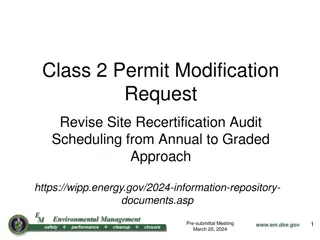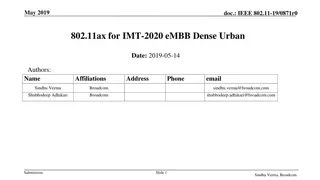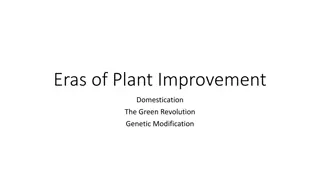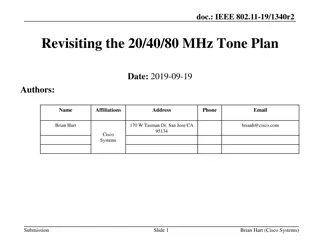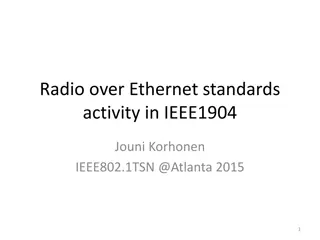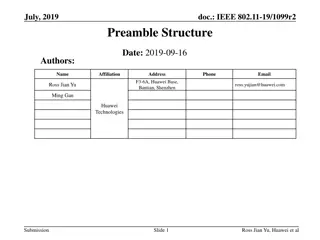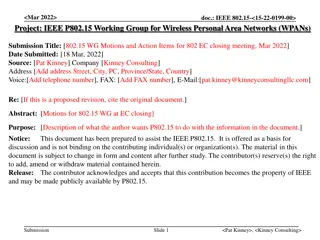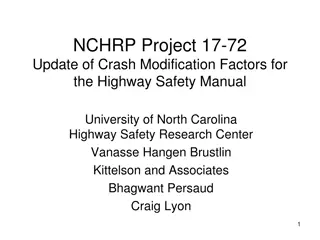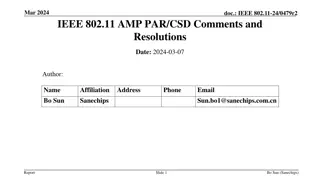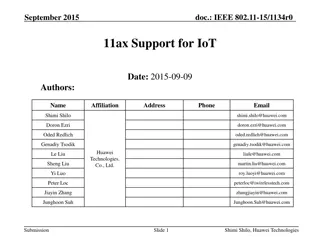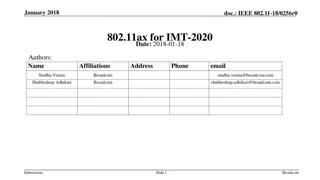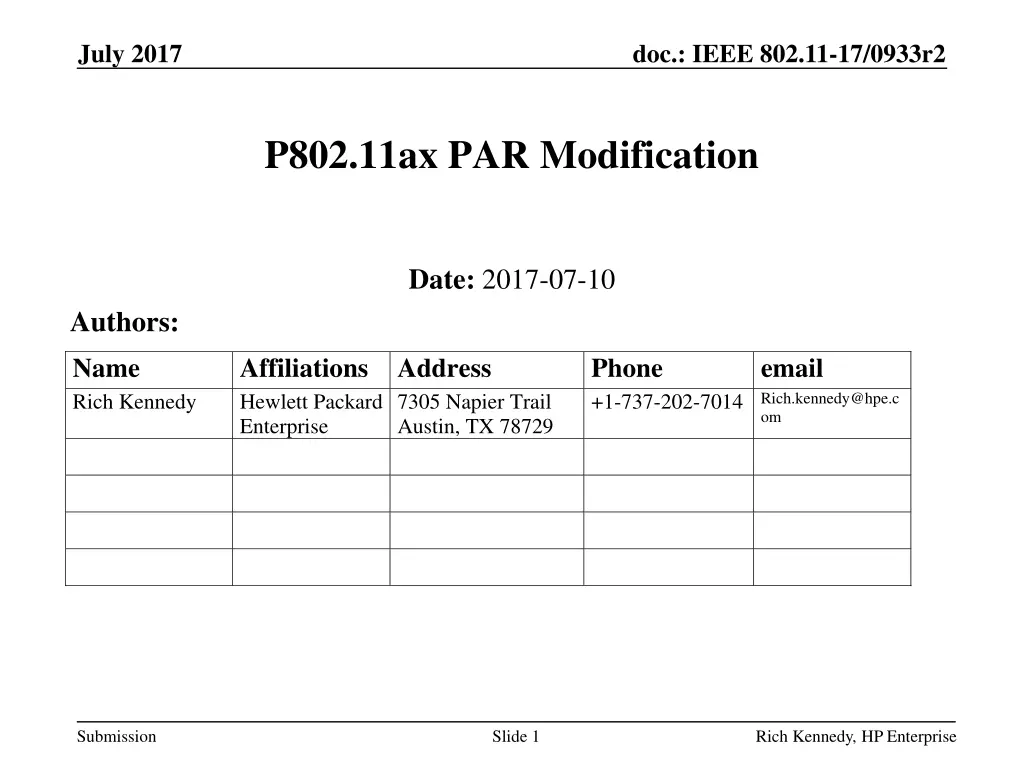
IEEE 802.11ax PAR Modification Proposal Overview
This document outlines a proposal to modify the IEEE P802.11ax High Efficiency WLAN PAR by raising the frequency band from 6 GHz to 7.125 GHz. It discusses the reasons for this modification, the impact on current schedules, and the steps being taken in regulatory bodies. The shift to the 6 GHz band aims to address the increasing spectrum needs of the Wi-Fi industry and outlines the new channels required for operation.
Download Presentation

Please find below an Image/Link to download the presentation.
The content on the website is provided AS IS for your information and personal use only. It may not be sold, licensed, or shared on other websites without obtaining consent from the author. If you encounter any issues during the download, it is possible that the publisher has removed the file from their server.
You are allowed to download the files provided on this website for personal or commercial use, subject to the condition that they are used lawfully. All files are the property of their respective owners.
The content on the website is provided AS IS for your information and personal use only. It may not be sold, licensed, or shared on other websites without obtaining consent from the author.
E N D
Presentation Transcript
July 2017 doc.: IEEE 802.11-17/0933r2 P802.11ax PAR Modification Date: 2017-07-10 Authors: Name Rich Kennedy Affiliations Address Hewlett Packard Enterprise Phone +1-737-202-7014 Rich.kennedy@hpe.c email 7305 Napier Trail Austin, TX 78729 om Submission Slide 1 Rich Kennedy, HP Enterprise
July 2017 doc.: IEEE 802.11-17/0933r2 Overview This submission proposes a modification for the IEEE P802.11ax High Efficiency WLAN PAR, to raise the top end of the frequency band from 6 GHz to 7.125 GHz, and indicate that new Operating Classes will be required to support the new channels. Submission Slide 2 Rich Kennedy, HP Enterprise
July 2017 doc.: IEEE 802.11-17/0933r2 Introduction Why is a PAR modification needed? Why now? What do we want to accomplish? What impact will this have on the current TGax schedule? Next steps Questions? Submission Slide 3 Rich Kennedy, HP Enterprise
July 2017 doc.: IEEE 802.11-17/0933r2 Why is a PAR modification needed? Recent spectrum needs studies indicate that by 2020 the Wi-Fi industry will require an additional 600-800 MHz of spectrum to support the current growth curve; 1.2-1.6 GHz by 2025 The U-NII-2b band we expected to open is now off the table 160 MHz in the middle of the 5 GHz band is no longer possible Opening the 6 GHz band will provide as much as 1.2 GHz of spectrum The current scope of the PAR includes this statement: This amendment defines operations in frequency bands between 1 GHz and 6 GHz. The statement must be changed to include the 6 GHz band (i.e., 1- 7.125) New Operating Classes will be needed to delineate the channel plan for the 6 GHz band Slide 4 Submission Rich Kennedy, HP Enterprise
July 2017 doc.: IEEE 802.11-17/0933r2 The 5 GHz Band ? Submission Slide 5 Rich Kennedy, HP Enterprise
July 2017 doc.: IEEE 802.11-17/0933r2 The Proposed 6 GHz Band Yellow = may required reduced power for incumbent protection Black = not available in some locations Submission Slide 6 Rich Kennedy, HP Enterprise
July 2017 doc.: IEEE 802.11-17/0933r2 Why now? The wheels of regulatory change are slow, but have already begun moving The FCC is looking at 6GHz for unlicensed designation, process is expected to take ~2 years once started FCC Notice of Inquiry including the 6 GHz band due soon The ETSI process has started, but begins with a study of the band that will officially start in September, and run though December 2018 CEPT ECC WG FM agreed to request WG SE to conduct studies for WAS/RLAN applications in 5925-6425 GHz. SE24 to start the study at September meeting with TR 103 524 as input Submission Slide 7 Rich Kennedy, HP Enterprise
July 2017 doc.: IEEE 802.11-17/0933r2 Why Now? [2] An 802.11 technology capable of operating in the target band in the time period that the spectrum will likely become available demonstrates that market need aligns with technical capability the only thing standing in the way of user benefit is the regulatory designation 802.11ax positioned to use this spectrum once the channels are defined Submission Slide 8 Rich Kennedy, HP Enterprise
July 2017 doc.: IEEE 802.11-17/0933r2 What do we want to accomplish? This PAR modification effects what can be done with 802.11ax; does not force any changes to the current project Shows the regulators the importance of keeping the regulatory process moving in a timely manner Actual market impact if process bogs down Industry has given this effort a head start; we need to be ready with standards and product changes for the late 2019 timeframe As this is effectively an extension of the 5 GHz band, the changes are straightforward This is the future of 802.11ax; more 80 MHz channels and support for wider bandwidth applications Without the designation we will soon be limited in what we can accomplish Submission Slide 9 Rich Kennedy, HP Enterprise
July 2017 doc.: IEEE 802.11-17/0933r2 What impact will this have on the current TGax schedule? None Submission Slide 10 Rich Kennedy, HP Enterprise
July 2017 doc.: IEEE 802.11-17/0933r2 Next steps We will continue to discuss as necessary in TGax The 802.11 WG will vote to approve the PAR modification this week The actual submittal will take place at the November Plenary The 802 EC will approve the modification and place it on the December NESCOM agenda Submission Slide 11 Rich Kennedy, HP Enterprise
July 2017 doc.: IEEE 802.11-17/0933r2 Questions? Submission Slide 12 Rich Kennedy, HP Enterprise

